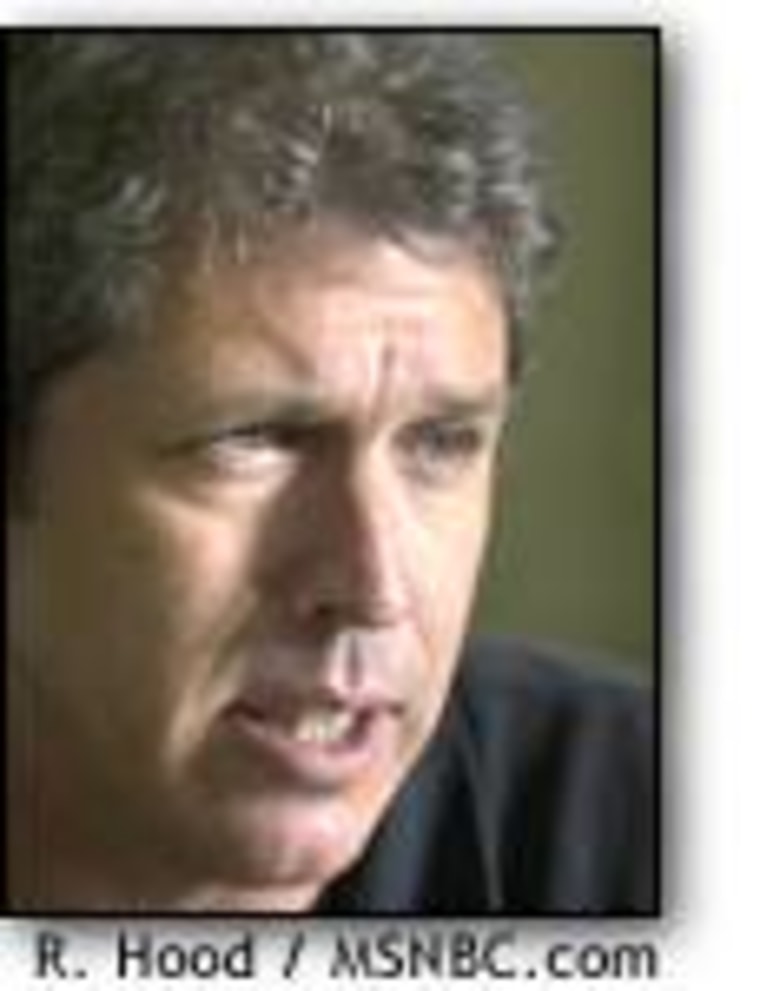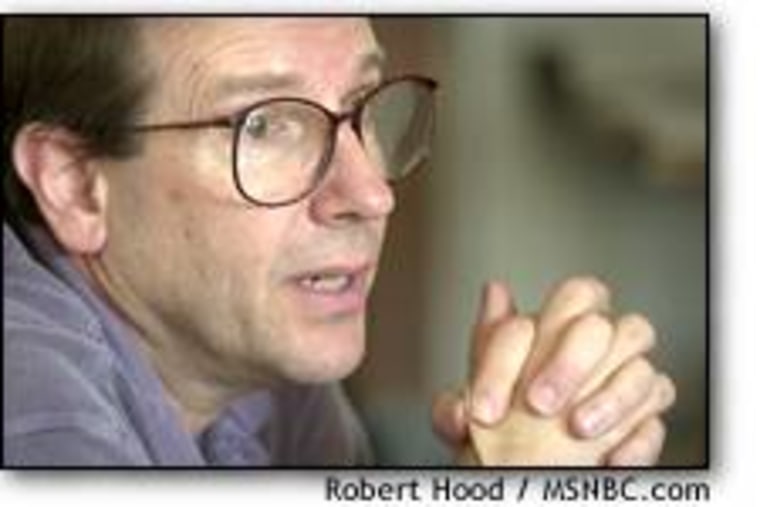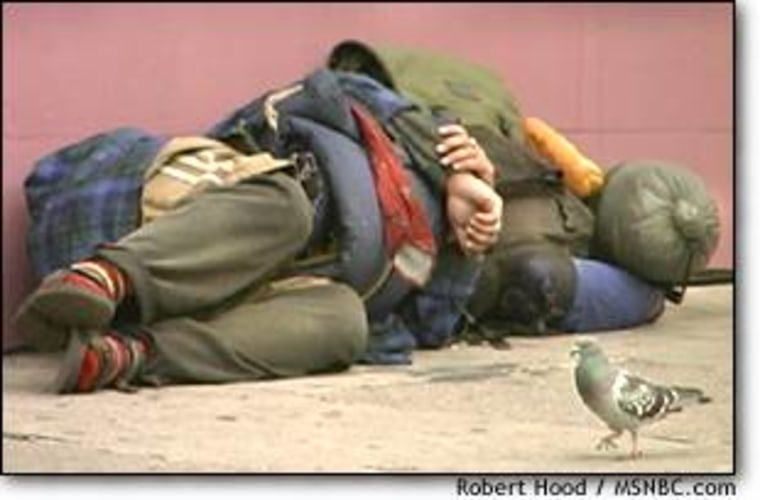The irony was that Mark Miller didn’t do drugs. Miller, “better known as Miss Miller” as he’ll tell you, came to San Francisco to pursue a career as a dancer. It wasn’t until he was in his late 20s that he first tried ecstasy. “I actually snubbed people who did drugs and alcohol,” he says.
Then one weekend in 1994 while partying down in Palm Springs, Miller tried his first “bump” of methamphetamine. It was a rush, and he was hooked.
“It made me feel confident, self-assured,” he says. “Then it took on a whole new meaning to me. I became a partier.”
He haunted the clubs of San Francisco, his nights filled with drugs like ecstasy, meth and GHB, and with dancing and sex. The next day, he would often do another hit of speed to recover. Within two years, Miller had become a porn actor, a stripper and a male prostitute.
“I was a person of great promiscuity,” he recalls — one reason he ultimately became HIV-positive.
Miller began to try new ways to do meth, at first snorting and smoking, then taking it anally. His addiction grew, and he was thrown out of his apartment and ended up on the streets, searching to string along his high.
“One time, I was up seven days on speed,” he remembers. “I was out in public fondling myself.” San Francisco police found him and took him to the hospital.
“I woke up the next day thinking I was having a dream,” he says, “when I was living it.”
Even then, Miller kept using meth “every way imaginable.” By the fall of 1999, he was going through two quarter-grams a day. Finally, he learned to inject himself with the drug — and realized he needed help.
“That moment was a moment of clarity to me,” he remembers, “where I said, ‘Enough. Please, God, help me. I’m dying.’”
One city's legacy
Though meth has spread rapidly through rural America, it remains a crisis in urban centers, especially on the West Coast. Like other big cities in the West, San Francisco has a major meth problem. Seen as early as 1978 in the city’s gay bathhouses, it could keep users up for days on end and enhance sexual pleasure. With the onset of AIDS, it was a popular but sometimes deadly pleasure and a major factor in the transmission of HIV, hepatitis B and C and syphilis.
“If you’re at a party where a lot of people are injecting, when you put your needle down, someone else may pick it up,” says psychologist Michael Siever, who founded the Stonewall Project, which offers meth counseling to the city’s gay community.
The city’s meth roots stretch decades. In 1967, a 28-year-old doctor named David Smith who was living in the Haight Ashbury neighborhood was shocked to find that plans for the Summer of Love gathering included no contingency to help any of the expected 100,000 stoned kids with medical problems from bad trips to bad hygiene. Fresh out of medical school, Smith and other young doctors organized the Haight Ashbury Free Medical Clinic, which offered free services to the flower children and hippies who came to its door.
Haight Ashbury also had other visitors that summer, the Hell’s Angels, who had a fondness for a drug then called crank or speed.
“It was the ‘make love, not war’ era, so the view was that psychedelic drugs were a route to non-violence,” Smith recalls. “And then all of a sudden, you started seeing speed and violence and rip-offs, psychosis and craziness.”
Smith and his team decided to step in. But it was too late for Haight Ashbury. Speed had come to stay in San Francisco.
“Speed had destroyed the dream that was the Summer of Love,” Smith says.
Helping hand for addicts
Some 33 years later, the clinic still helps meth addicts by offering medical care and residential recovery programs. The staff believes in harm reduction, which encourages addicts to use clean needles and condoms during sex. As Dr. Joseph Elson, the clinic’s medical director, explains: “We tend to be honest and not judgmental.”

Addicts’ medical problems are manifest — from alarming weight loss (meth users often forget to eat) to skin infections and abscesses from poor hygiene. Many users also suffer mental problems, including paranoia and depression. Addicts may develop meth psychosis, which requires acute detox: several days in isolation to leach the drug out of the body, often accompanied by drugs to help with tweaking, the spastic reflexes that often accompany paranoia on the way down from a meth high.
“What they basically need to do is to hibernate,” Elson says. ”[We tell them,] ‘Here’s a couple valium. Go and hibernate for a day or two.’”
Coming down is difficult because meth can take users to the height of euphoria and sexual frenzy. The typical high lasts 12 hours or longer and some users will sometimes stay up for days, chaining themselves along with hit after hit. Others will use meth to suppress appetite or to help them work long hours, hence the drug’s growing popularity in Silicon Valley.
A cheaper, better rush
That’s why Stephanie Lujan tried meth. Growing up in New Mexico, she managed a fast-food restaurant and occasionally smoked pot. Her friends got her started on a tempting new drug. The initial rush was “this very intense surge of electric energy through the body,” she recalls. “It felt as though your mind was moving faster.
“I felt like I was superhuman because I would think more, I could accomplish more.”
Lujan, now 31 and a counselor who helps run one of the clinic’s residential treatment programs, described the elaborate ritual she and her friends would perform when they did meth. Upon scoring a bag, she and her friends would admire the size of the “rocks,” clumps of powdered meth, and would chop the rocks into lines of powder with a razor blade, much like cocaine. For up to an hour, they would play intensely with their drugs, cutting and recutting lines of meth to snort. “I very much enjoyed doing that,” she says.
They would get high and chatter for hours, quickly jumping from conversation to conversation. If she had to work, the meth would give her extra energy. The drug’s economics — cheaper than cocaine — only added to its appeal.
“I was like, ‘Oh my God, you get more bang for your buck,’” Lujan recalls. “Why would you do something that costs more and doesn’t last as long?”
Even for moderate users, meth has a steep addiction curve: It’s remarkably easy to get hooked and painfully hard to get off it. Almost as soon as the high begins, users start to fear the crash, especially the tweaking and paranoia. When a user finally comes down, his or her surroundings seem bleak. As Lujan describes it: “The world was black and dark and I was totally depressed.”
Fear of the crash
Users coming down usually experience depression and a profound sense of anhedonia, the complete lack of emotional sensation.

This is when users are most receptive to treatment. “Nobody wants to face the crash,” says John DiDomenico, clinical supervisor of Haight Ashbury’s detoxification, rehabilitation and after-care program. “It’s real easy to grab them at that point.”
Users undergo intensive counseling in one-on-one and group sessions. The first step, called “early recovery,” is about helping addicts learn how to stay clean and rebuild their lives.
“A lot of what we get into here is, ‘How do I have social relationships? How do I have sex without doing speed?’” DiDomenico says.
Users also must learn to deal with powerful “triggers” that can start a craving — anything from a specific street corner to a particular friend or a bit of drug paraphernalia.
“A lot of times, people can get triggered at support meetings when they hear stories about using,” says Dr. Robert Hood, a clinic psychiatrist.
Intensive therapy usually lasts about six months, but an addict may need more casual group counseling for several years.
Of course, in rare cases, getting off meth can be simpler than that. Lujan kicked her meth habit after the third time she overdosed on it.
“I got so sick that I have not had a craving for it since,” she says.
Mark Miller’s recovery began in 1999. He was clean for nine months before having a relapse. Miller went back into treatment and by late 2000, at age 36, he had been clean again for almost three months, working at Gold’s Gym and exercising every day. He takes antidepressant medication, attends church on Sunday and goes to recovery group meetings almost daily. He is learning to cope with his HIV status, and hopes within a year to be back out auditioning for dancing roles in musicals.
Much of the recovery process, he says, has been about realizing what meth covered up in his life. Among other things, he would use it to have copious amounts of sex, and he used sex as a way to avoid other problems.
“Intimacy is one of my biggest fears,” he admits. “I feel insecure because I don’t feel worthy of anything in this world.”
Miller acknowledges he could easily feel sorry for himself, but he says part of the healing process has been learning to cope with how his life has turned out.
“I don’t have to be a crybaby about it,” he offers, defiantly.
